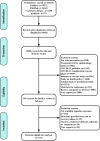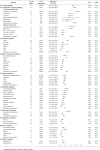A systematic review and meta-analysis of long term physical and mental sequelae of COVID-19 pandemic: call for research priority and action
- PMID: 35668159
- PMCID: PMC9168643
- DOI: 10.1038/s41380-022-01614-7
A systematic review and meta-analysis of long term physical and mental sequelae of COVID-19 pandemic: call for research priority and action
Abstract
The long-term physical and mental sequelae of COVID-19 are a growing public health concern, yet there is considerable uncertainty about their prevalence, persistence and predictors. We conducted a comprehensive, up-to-date meta-analysis of survivors' health consequences and sequelae for COVID-19. PubMed, Embase and the Cochrane Library were searched through Sep 30th, 2021. Observational studies that reported the prevalence of sequelae of COVID-19 were included. Two reviewers independently undertook the data extraction and quality assessment. Of the 36,625 records identified, a total of 151 studies were included involving 1,285,407 participants from thirty-two countries. At least one sequelae symptom occurred in 50.1% (95% CI 45.4-54.8) of COVID-19 survivors for up to 12 months after infection. The most common investigation findings included abnormalities on lung CT (56.9%, 95% CI 46.2-67.3) and abnormal pulmonary function tests (45.6%, 95% CI 36.3-55.0), followed by generalized symptoms, such as fatigue (28.7%, 95% CI 21.0-37.0), psychiatric symptoms (19.7%, 95% CI 16.1-23.6) mainly depression (18.3%, 95% CI 13.3-23.8) and PTSD (17.9%, 95% CI 11.6-25.3), and neurological symptoms (18.7%, 95% CI 16.2-21.4), such as cognitive deficits (19.7%, 95% CI 8.8-33.4) and memory impairment (17.5%, 95% CI 8.1-29.6). Subgroup analysis showed that participants with a higher risk of long-term sequelae were older, mostly male, living in a high-income country, with more severe status at acute infection. Individuals with severe infection suffered more from PTSD, sleep disturbance, cognitive deficits, concentration impairment, and gustatory dysfunction. Survivors with mild infection had high burden of anxiety and memory impairment after recovery. Our findings suggest that after recovery from acute COVID-19, half of survivors still have a high burden of either physical or mental sequelae up to at least 12 months. It is important to provide urgent and appropriate prevention and intervention management to preclude persistent or emerging long-term sequelae and to promote the physical and psychiatric wellbeing of COVID-19 survivors.
© 2022. The Author(s), under exclusive licence to Springer Nature Limited.
Conflict of interest statement
The authors declare no competing interests.
Figures





References
Publication types
MeSH terms
LinkOut - more resources
Full Text Sources
Medical
Miscellaneous

